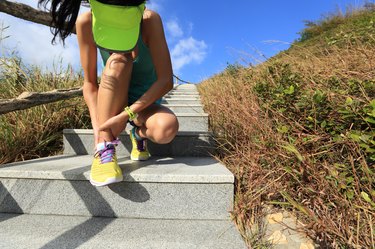
Achilles tendinitis is a condition characterized by pain at the back of the heel where the Achilles tendon inserts into the calcaneus bone. Gout is a disease in which the pain is usually felt in the big toe and, less often, in the other toes, the hands and wrists.
Achilles Tendinitis Causes
Video of the Day
Achilles tendinitis is often caused by a drastic increase in running mileage or excessive uphill or downhill training. The abnormal stresses placed upon the tendon cause it to become inflamed, and pain ensues. Typically someone will complain of pain in the morning with the first few steps taken, then the pain subsides with further movement.
Video of the Day
Gout History
Gout has been referred to as the "rich man's disease," because it is a disorder of amino acid metabolism, specifically those found in meat and red wine. In centuries past only those who had the financial means to consume these products were able to do so, and therefore gout was not found among poorer people.
Achilles Tendinitis Pathology
While Achilles tendinitis can be caused by over-training, it can also have biomechanical origins such as over-pronation of the feet (the ankles roll inwards slightly with each step), overly tight hamstring and calf muscles and even faulty running technique with landing too far back on the heel.
Gout Pathology
Patients with gout typically complain of pain in one of their big toes. This pain is due to the deposition of uric acid crystals in the soft tissues surrounding the affected joint. An article in the June 28, 1979, "New England Journal of Medicine," reported a theory that the crystal deposition occurs in the peripheral joints because of their lower temperature, which decreases uric acid solubility and promotes deposition into the tissues. If left untreated, gout can erode bony joint margins and lead to visible and irreversible changes on X-ray.
Achilles Tendinitis Treatment
Treatment for Achilles tendinitis, first and foremost, involves rest. Evaluation by a professional to determine and remedy biomechanical problems is also a necessity. Shoes with a strong heel counter and orthotics can help keep the foot in its proper position and reduce aberrant movement of the foot. Stretching and strengthening of the calf and hamstring muscles (on the non-affected side as well) can be undertaken once the foot is pain-free and will help to prevent recurrences.
Gout Treatment
Gout treatment focuses on reducing the uric acid level in the blood. A medical doctor can prescribe those medications that would be appropriate. For the individual, avoidance of low-calorie diets, diuretics and aspirin are necessary as these all promote urate retention in the kidney. Additionally it is important to stay well-hydrated and refrain from other dietary offenders such as red meat and wine that promote the uric acid formation.
Is this an emergency? If you are experiencing serious medical symptoms, please see the National Library of Medicine’s list of signs you need emergency medical attention or call 911.